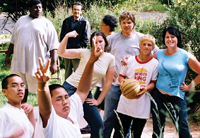 Santa Cruz, Calif.
Santa Cruz, Calif.
(831) 459-2424
renaissance_scholars@ucsc.edu
Objective: Help foster youth get into college and stay there.
In a Nutshell: Provides youth from high schools and community colleges with support that includes college-preparation advice, academic planning, transfer and application workshops, and campus visits. A summer camp for younger foster youth gets them to think about college as a realistic option. Youths who ultimately attend UCSC get priority enrollment and an academic adviser who is on the program staff and is trained in foster youth issues.
Where and When: Renaissance began in 2004, growing out of an alumni-led volunteer organization at UCSC called the Smith Scholastic Society. The program is administered by the university, but relies on collaborative efforts at high schools, social service agencies, Court Appointed Special Advocates (CASA) offices and community centers. Volunteers and staff at those agencies work with the Renaissance Scholars in the community, while the UCSC program staff focuses mostly on planning Renaissance events and advising the member youth who are in college.
Who Started/Runs It: The Smith Society was started by Bill Dickinson, a UCSC alumnus and former foster youth. Renaissance Program Coordinator Ismana Carney oversees a staff of two full-timers and several student assistants.
Obstacles: Carney says the first challenge was “negotiating the tension of a constraint-free volunteer community trying to work within the constraints and legal complexities of a university bureaucracy.” The solution was to have the university run the Renaissance Scholars program, while the volunteer coalition – whose work includes helping the Renaissance Scholars – remains as the Smith Society.
Cost: $185,000 a year.
Who Pays: The Stuart Foundation and the Pottruck Family Foundation, both based in San Francisco, provide most of the funding. The university covers benefits and pension plans for the three staff members, and provides infrastructure support, such as office space and supplies.
Youth Served: Foster youth from seven counties surrounding UCSC can enroll in the program starting as early eighth grade and stay connected with it through undergraduate and graduate school. Among current participants, 153 are in high school, 47 are in community college and 40 attend UCSC.
Youth Turn-On: Young foster children particularly enjoy the weekend camp, which balances information about college with such activities as night walks, basketball and campfire singing.
Turn-Off: Some youths do not like to be singled out as foster children. And Carney says that “mandatory meetings at campus are not always popular.”
What Still Gets in the Way: “There are few opportunities for collaboration between social service agencies, organizations and educational institutions” in each county, Carney says. “One of our primary challenges is to forge effective links between all parties involved in helping foster youth realize their dreams of a college education.” Carney would also like to add staff members who are trained to deal with issues facing foster youth.

























